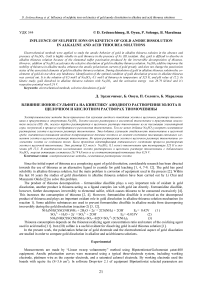Influence of sulphite ions on kinetics of gold anode dissolution in alkaline and acid thiourea solutions
Автор: Erdenechimeg Dolgor, Oyua Batsuh, Solongo P., Maralmaa Byambaa
Журнал: Вестник Бурятского государственного университета. Философия @vestnik-bsu
Рубрика: Химия
Статья в выпуске: 3, 2014 года.
Бесплатный доступ
Electrochemical methods were applied to study the anodic behavior of gold in alkaline thiourea solution in the absence and presence of Nа 2SO 3. Gold is highly soluble in acid thiourea in the presence of Fe (III) oxidant. But, gold is difficult to dissolve in alkaline thiourea solution because of the elemental sulfur passivation produced by the irreversible decomposition of thiourea. However, addition of Nа 2SO 3 accelerates the selective dissolution of gold in alkaline thiourea solution. Nа 2SO 3 additive improves the stability of thiourea in alkaline media, enhances the anodic polarization current of gold greatly, and does not change the passivation states of the associated elements of gold in alkaline thiourea solution. During dissolution of gold in alkaline thiourea solution the coelements of gold do not show any hindrance. Identification of the optimal condition of gold dissolution process in alkaline thiourea was carried out. It is the solution of 0.5 mol/l of Nа 2SO 3; 0.1 mol/l of thiourea in temperature of 323 К, and pH value of 12.5. In kinetic study, gold dissolved in alkaline thiourea solution with Nа 2SO 3 and the activation energy was 26.79 kJ/mol and it’s respective potential was 0.24 V.
Electrochemical methods, selective dissolution of gold
Короткий адрес: https://sciup.org/148182384
IDR: 148182384 | УДК: 544
Текст научной статьи Influence of sulphite ions on kinetics of gold anode dissolution in alkaline and acid thiourea solutions
Since the initial report of thiourea as a complexing agent of gold dissolution, considerable research has been directed towards the use of thiourea as an alternative ligand to cyanide for gold leaching [1, 4, 7-9, 12]. The gold has good solubility in alkaline thiourea solution, but the main problem is corrosion of equipment used in the process [2]. Within the last 10 years the studies of gold dissolution in alkaline thiourea solution have been carried out by Li Chai and Masazumi Okido [2] to solve this problem.
The product of thiourea decomposition – formamidine disulfide plays a very important role of oxidant in gold dissolution, another product is thiourea acting as a ligand complex ion with gold ion directly. Formamidine disulfide, however, further decomposes irreversibly to elemental sulfur, which causes thiourea to be consumed excessively [4]. This increases the consumption of thiourea [2, 4]. However, formamidine disulfide is evolved as the decomposed product of thiourea and plays an important oxidant role in gold dissolution in alkaline thiourea solution mechanism (in reaction 1). Some additive substances are used to prevent formamidine disulfide in alkaline media from decomposing irreversibly during the gold dissolution (reaction-2) [3, 12].
NH2(NH)CSSC(NH)NH2 + 2H2O + 2e- = 2CS(NH2) + 2OH- E0= 0.42V(1 )
SO42- + H2O + 2e- = SO32- + 2OH- E0= -0.033V(2)
NH2(NH)CSSC(NH)NH2+SO3-+H2O=SO4-2+2CS(NH2)2
Thiourea consumption depends on the thiourea/oxidizing agent concentration ratio and nature of the oxidizing agent used in acid media [11]. Iron (III) sulfate is a useful oxidant for dissolving gold in acid thiourea solution [1].
In the present work, the polarization behavior of gold electrode and the electrochemical aspect of gold dissolution are studied in order to compare gold dissolution in alkaline and acid thiourea solutions.
Experimental
Measurements are made by “Linear sweep voltammetry” method using Bipotentiostat/Galvanostat µstat-400 equipment. Anodic polarization curves were measured using a typical three-electrode system, including working electrode, platinum wire as the counter electrode, and a saturated calomel electrode. By working electrode used the boards with squire Au (S=3.6 cm2). In software Dropview 2.1 of equipment Bipotentiostat selected parameters are starting potential of -0.2 V, finishing potential of 0.8 V, scan rate 10 mV/sec [5, 6]. The electrode polarization curve in relation to potential was obtained. Solution was controlled by pH- meter adding 0.5 mol/l H2SO4 or NaOH.
Result and discussion
Effect of Nа 2 SO 3 on gold dissolution in alkaline thiourea solution. Anodic gold electrode polarization curve is obtained in both cases with or without Nа 2 SO 3 (Fig 1). When Nа 2 SO 3 is added , the sharp rise of current density from 0.1 V shows effective dissolution of gold in comparison with the solution without Nа 2 SO 3.
The pH effect for gold dissolution in thiourea solution. The effect of pH on the anodic polarization curves for the gold electrode in 0.1mol/l thiourea solution containing 0.5 mol/l Nа 2 SO 3 is shown in Fig. 2. The increase of pH over 12.5 has shown the decrease of gold dissolution potential. This indicates that gold dissolves in the alkaline media faster than in the acidic media in case the solution contains thiourea and sodium sulfite.
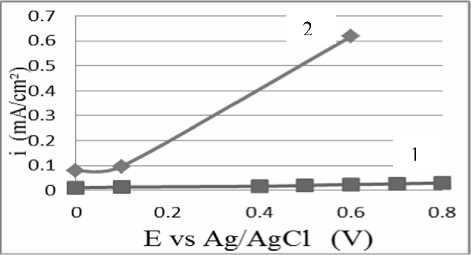
Fig. 1. The effect of Nа2SO3 on gold dissolution in alkaline thiourea solution, 1-with Nа 2 SO 3 , 2 - without Nа 2 SO 3
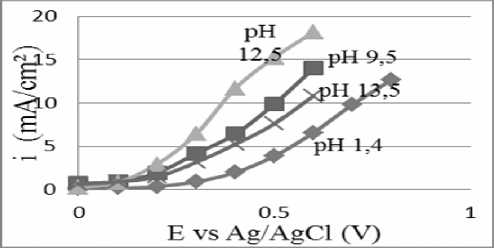
Fig. 2. The effect of pH on the anodic polarization curves for the gold electrode
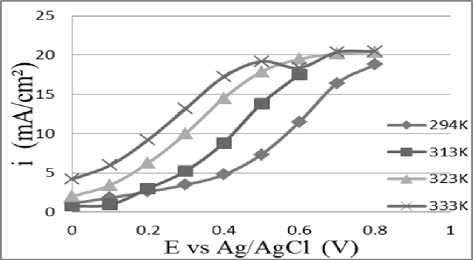
Fig. 3. Temperature effect on anodic current of Au electrode in alkaline thiourea
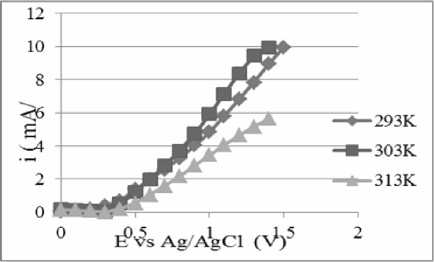
Fig. 4. Temperature effect on anodic current of Au electrode in acid thiourea
The temperature effect for gold dissolution in acid and alkaline thiourea solution. The effect of temperature 294, 313, 323 and 333 K on the anodic current of gold electrode in 0.1mol/l thiourea solution with pH-12.5 in presence of Na 2 SO 3 is studied. The temperature effect is high (Fig 3). In temperature of 333 K the anode polarization is the highest but respective potential curve has bended at the point of 0.5 V potential. It shows that decomposition of gold-thiourea complex takes place if the potential is higher than 0.54 V and the temperature is above 50oC (323 K). Considering this gold dissolution is more favorable at 323 K in alkaline thiourea solution with presence of Na2SO3 (Fig. 3).
In Fig. 4. the effect of temperature 293, 303 and 313 K on the anodic current of gold electrode in 0.05 mol/l thiourea solution with pH 2 is shown. The gold dissolution was dependent on the condition, and temperature effect was poor in acid solution. Depending on the temperature effect on the dissolution the respective region can be determined [10]. The gold dissolution rate in acid thiourea solution can be determined by the last region or by diffusion region [1].
To determine the gold dissolution rate in alkaline thiourea solution and its respective region curve is built in 0.54 V and 0.24 V potentials (Fig. 5). Activation energy of each potential is estimated by Arrhenius’ equation (1).
k=Aexp(-E/RT) (1)
Calculated activation energy in 0.24 V potential is 26.79 kJ/mol and the activation energy in 0.54 V potential is 17.39 kJ/mol. It shows that the dissolution rate of gold can be determined in kinetic regions when potential is 0.54 V. When potential is 0.24 V activation energy is between 20 kJ/mol – 40 kJ/mol [11] and the dissolution rate of gold can be determined in both of diffusion and kinetic regions.
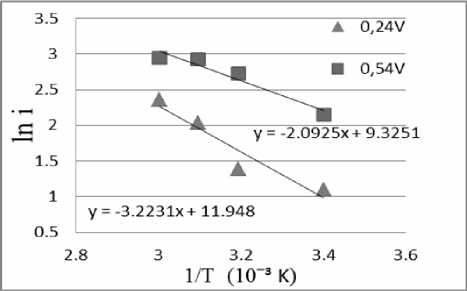
Fig. 5. Relation between ln i vs 1/T
Gold is difficult to dissolve in alkaline thiourea solution in the absence of Na 2 SO 3 due to the passivation by elemental sulfur. The addition of Na 2 SO 3 to alkaline thiourea solution makes the selective dissolution of gold possible. The additive Na 2 SO 3 enhances the anodic current of the gold electrode drastically and prevents thiourea in alkaline media from decomposing irreversibly.
The current research provided a basis for the selective extraction of gold from scrap using alkaline thiourea solution, to which Na 2 SO 3 has been added. The activation energy of reaction calculated respectively are 26.79 kJ/mol, 17.39 kJ/mol at the potentials of 0.24 and 0.54 V. The dissolution rate of gold can be determined both in diffusion and kinetic regions. The optimal concentration of acid thiourea to gold dissolution is determined as 0.05 М by electrochemical method and the optimal temperature is 303 K (30oC). The anodic current of gold dissolution in alkaline thiourea is more than the gold dissolution in acid thiourea solution.
Список литературы Influence of sulphite ions on kinetics of gold anode dissolution in alkaline and acid thiourea solutions
- Bayar B., Erdenechimeg D. Chemical Technology of Gold. -Ulaanbaator, 2003. -P. 5-10, 46-50.
- Liyuan C., Masazumi O., Wanzhi W. Effect of Na2SO3 on electrochemical aspects of gold dissolution in alkaline thiourea solution//Hydrometallurgy. -1999. -P. 255-266.
- Liyuan C., Masazumi O. Dissolution theory of gold in alkaline thiourea solution. Thermodynamics on dissolution of gold in alkaline thiourea solution containing Na2SO3//Trans. Nonferrous Met. Soc. China. -1999. -P. 646-650.
- Wang Y.-Y., Chai L.-Y. Optimization of efficient stable reagent of alkaline thiourea solution for gold leaching//J. Cent. South Univ. Technol. -2003. -V. 10, № 4. -Р. 292-296.
- Lin J.-C., Huarng J.-J. Electrochemical stripping of gold from Au-Ni-Cu electronic connector scrap in an aqueous solution of thiourea//J. of Applied electrochemistry. -1994. -P. 158-159.
- Dropsens “Instrumental Manual” μстат 400 and DropView 2.1 Software. -Spain, David Hernandez Santos, 2009. -P. 1-14.
- Wei D., Chai L., Okido M. Gold leaching in alkaline thiourea solution//J. of The Electrochemical Society. -1999. -P. 559-563.
- Bolzan A.E., Piatti R.C.V., Arvia A.J. Electrochemical processes at gold-thiourea containing aqueous acid solution interfaces//J. of Electroanalytical Chemistry. -2003. -P. 19-34.
- Li J., Miller J.D. Reaction kinetics for gold dissolution in acid thiourea solution using formamidine disulfide as oxidant//Hydrometallurgy. -2002. -P. 215-223.
- Shevtsova O.N., Zelinskii A.G. Anodic behavior of gold in acid thiourea solutions: A Cyclic voltammetry and Quartz microgravimetry study//Russian Journal Electrochemistry. -2006. -V. 42, № 3. -P. 239-244.
- Maslenitskii I.N., Chugaev L.V. Metallurgy of pressures metals. -Moskow, 1987. -P. 74-109.
- Tremblay L., Deschenes G., Ghali E., McMullen J., Lanouette M. Gold recovery from a sulphide bearing gold ore by percolation leaching with thiourea//International journal of minerial processing. -1996. -V. 48. -P. 225-244.

